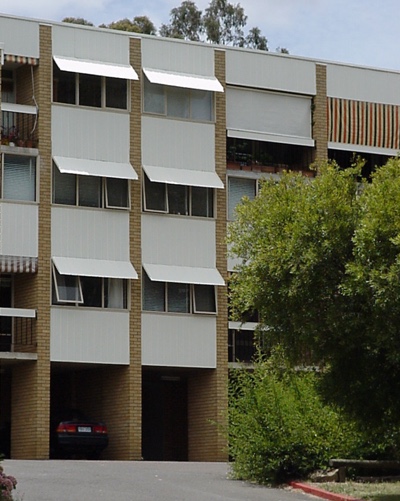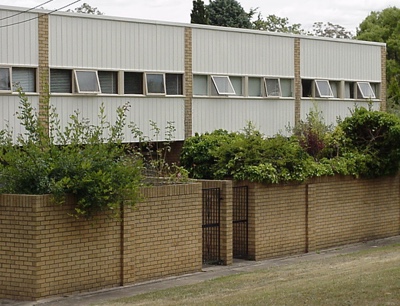Campbell Group Housing (1964)

Campbell Group Housing: apartments
The Campbell Group Housing comprises a group of 42 apartments and 32 attached houses in nine buildings and was designed by Harry Seidler and Associates in 1964 for the Australian National University (ANU). Construction was completed in 1968. The ANU sold the houses and apartments to individual owners and they are now under the control of a body corporate. The Group is located on the corner of Blamey Crescent and Edmondson Street, Campbell.
The group is a late example of the post-war international style, with its cubiform overall shape, curtain wall and large sheets of glass. They represent one of a small number of medium density housing projects in Canberra designed by Seidler, the other major ones being the Garran Housing for the ANU (1968, demolished in 1999) and Lakeview (1982). The group of 42 apartments is the only such example in Canberra designed by Seidler. Comparable apartment blocks by Seidler in Sydney include the Arlington Apartments at Edgecliff (1966).
Other buildings in Canberra designed by Seidler include the Canberra South Bowling Club (1959), Ethos House (1970) and the Barton Offices (1973). Seidler designed two detached houses in Canberra: the Bowden House (1951–52) and a house at 12 Yapunyah Street, O’Connor (1956), which has been demolished.
Significance
The Campbell Group Housing is listed on the ACT Chapter of the Australian Institute of Architects (RAIA) Register of Significant Twentieth Century Architecture. It is regarded by the AIA as being an important example of the post-war international style of Harry Seidler, one of Australia’s most important architects of the late twentieth century.
The buildings exhibit a number of the elements specific to the post-war international style, including expressed structural frames, plain, smooth wall surfaces and large sheets of glass. They also display other architectural elements of this style in the fenestration, overhangs and other external sun control devices. The façades of the apartment blocks have roots in the European art movements of the 1920s and 1930s and are carefully composed to produce abstract, balanced patterns across the development.
It is the most effectively planned and intact of the major medium density residential projects Seidler completed in Canberra. The demolition of his Garran Housing has increased the rarity and heritage value of the Campbell Group Housing.

Campbell Group Housing: townhouses
Description
The group contains four types of houses and three types of apartment, arranged in blocks of different length, staggered to create a spatial relationship between them. As a result, the repetition often found in terrace housing of this type has been avoided. Split level planning over the sloping site allows level access to private rear courtyard gardens on the uphill side of the houses and car access to the front of houses and some of the apartments.
Houses are arranged in pairs: each pair in Blocks 1, 3, 5 and 7 has a type A house (three bedroom) and a type B house (two bedroom). Blocks 2 and 6 each have two mirror-reversed pairs of type C houses (two bedrooms at the front without balconies) and block 4 has three mirror-reversed pairs of type D houses (two bedrooms). The result of this variation in housing types is that the skillion roofs of the different blocks slope to the west and east alternately, creating an interesting pattern across the site.
Each apartment building is six units wide, apartment types being E (two bedrooms), F (one bedroom) and G (bachelor). The plan arrangement is similar to that of the houses, with covered car spaces at road level and split level planning maintained to create a minimum of internal public access space and the location of all main living areas on the view side.
A single corridor in each block, entered from a glass walled central stair hall, serves all aboveground apartments. Half flights of stairs lead either up or down into the two bedroom apartments. Within each, an internal half flight of stairs connects living and sleeping areas. One bedroom apartments open directly from the corridors.
Materials are consistent across the nine blocks: yellow textured face brick walls, concrete floors, steel deck skillion roofs, lightweight steel infill walling painted white and fixed slatted aluminium awnings, also white. Additional sunshading is provided by blinds of black and white fabric. These materials combine to provide visual contrasts and patterns across the site.
Source
- Australian Institute of Architects RSTCA Citation No. R128